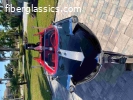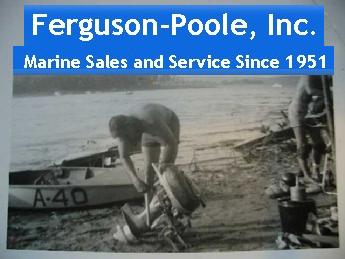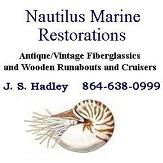FiberGlassics® would like to thank Jamil Mehdi for this article. This content is copyrighted, and cannot be reproduced in any form without written permission from the author.
Transoms, Floors, and Stringers
The transom, floor, and stringers in a boat are, collectively, the most important elements of its construction. Compromising even a single one of the three puts the safety of the vessel and the lives aboard in jeopardy.
To ignore or downplay issues with any or all of these components is to willfully tempt fate. Yet many times in my never-ending search for the next project, I will happen across a litany of derelict boats all being marketed as a “weekend project”, “one-day fix”, or “easy fix”.
I cringe when I see or hear these words because I already know that the seller either has no idea of what's involved or is actively trying to dupe would-be buyers. Either way, if the potential buyers take the seller at his word, major structural problems will end up being improperly repaired or dismissed outright.
While cosmetic problems go hand in hand with structural issues, a poorly cared-for finish is unlikely to result in the kind of catastrophic hull failure that can come from weakened transoms, floors, or stringers.
Transoms
This is the single most important part of an outboard boat, yet for some reason, it takes more abuse than any other part. We screw any number of trinkets and doo-dads into the transom. We hang hundreds of pounds of gyrating metal off of it. We spend our best of days trying our hardest to rip it right off the boat. We drill holes into it, assault it with solvents and grease, submerge it in water, and when we're done, we ignore it.
“It hasn't failed yet,” we say to ourselves.
If a transom was a person, it would be a leather-wearing masochist hanging out at some inner city, middle of the night, club with blacked out windows and a nondescript door that requires a password to enter. Inside, the transom would be chained up to a wall as sadists took turns whipping it and hanging clothes pins from its nipples.
Eventually a transom will succumb to its abuse. A wood cored transom is almost assured of wearing out long before the rest of the boat. Thankfully, the options available for rebuilding a transom are much greater today than they were fifty or sixty years ago.
Before we discuss how to rebuild a transom, it's probably a good idea to understand how they were built the first time.
Transom Construction
Your boat started off as just a hull, a silhouette of a boat. Structurally it would need to be strengthened and stiffened before ever seeing the water. The first step of this strengthening process was the installation of the transom.
In the 50s and 60s, the process for strengthening and stiffening a transom was a foregone conclusion. A wooden core was laminated to the inside of the fiberglass transom skin and a new build up of fiberglass was then laminated onto the wooden core. This process layering fiberglass, then wood, then fiberglass is known as sandwich construction.
There was some variation in the core material, but the mechanical properties of sandwich construction have never changed. To this day, transoms are largely built the exact same way.
Sandwich construction is an improvement over solid fiberglass because it is stiffer compared to solid fiberglass of equal weight. The problem with sandwich construction is that organic core materials, such as wood, rots when it gets wet. Boats, as you may already be aware, spend a great deal of time in a fairly wet environment.
Using a core material that is highly susceptible to water damage on a boat is a little like storing fireworks in the cabinet above the stove. Drilling holes in the transom to mount an outboard motor is like dangling the fuse next to the pilot light. Eventually the fuse is going to light. Eventually water will make its way into the core. Maybe there's a better idea.
Before we get into the myriad options available for replacement or the “how-to” part, we have to spend some time familiarizing ourselves with some of the mathematic principles behind sandwich construction. A working understanding of the concept is vital ensuring a safe repair.
The Core Principles
Cored fiberglass, or sandwich construction, as stated above, is stiffer than solid fiberglass of equal weight. But why?
The concept is the same as I-Beam construction. (Incidentally, it is also known as “H-beam”, which makes sense, but also cryptically known as “W-beam”, which stands for “wide flange”, and also the stupidly over-complicated “Double T” construction).
In an I-beam, two thin lengths of steel that are stiff in a left to right direction, but flimsy in an up and down sense are connected by a third piece of steel that is stiff in an up and down direction, but flimsy in a right to left sense. The result is an I-beam that is stiffer in every direction than a solid piece of steel that weighs the same.
So how does this translate to a transom with a core? A transom isn't made out of I-beams. It's made out of sheets of fiberglass bonded to each side of a solid core. That doesn't sound like the same thing at all.
Well, it is and it isn't.
Let's do a hypothetical experiment. Let's say you have two lengths of ½” thick fiberglass that are both exactly 10' long. When you lay them on top of each other, the outer edges line up perfectly. Now imagine you've taken a pencil and marked the edges of each piece in one foot increments.
If you then bent them into a U-shape. The edges of the fiberglass would no longer line up with each other. That's because the inside of the curve is a tighter radius than the outside of the curve.
If you looked at your pencil marks, you would see that they line up perfectly in the middle of the bend, but the further away from the middle you go, the bigger the gap between pencil marks. That gap is called "shearing".
Now if you repeated the experiment, but this time you screwed the two pieces together at each pencil mark, you would find that it's much harder to bend them at all. That's because the fasteners won't allow the two pieces to shear away from each other.
This is essentially what a core does. It prevents the two panels of fiberglass in a transom from bending by limiting their ability to shear away from each other. The thicker the core material, the stiffer it is. To illustrate this point, I'm going to steal some numbers from Nidacore's website (Nidacore is a manufacturer of composite core material. We'll discuss their products as well as other's a little later).
A sandwich construction of fiberglass-Nidacore-fiberglass was 7 times stiffer than the same amount of fiberglass without the core. (The thickness of the Nidacore was equivalent to the total thickness of the fiberglass) When the amount of core material was doubled, this number jumped to 37 times stiffer than fiberglass alone.
Stiffness vs. Strength
As you can see, adding a core between two fiberglass skins is a great benefit to stiffness. But stiffness and strength aren't the same thing. Confusing the two can be disastrous at sea.
In the previous example, 1” of core material was sandwiched between two ¼” fiberglass skins, resulting in stiffness 37 times greater than just ½” of fiberglass alone. But how much was the strength improved? The answer may shock you.
The increase in strength was hardly even noticeable. The overall increase was limited to the strength of ½” fiberglass plus the strength of the core material itself. It still takes a roughly equivalent amount of force to break through solid fiberglass as it does to break through cored fiberglass, the difference is that solid fiberglass is going to deflect, (bend), long before it fractures.
Now here's where it gets tricky.
When you hang a 250 lb outboard from your transom, any flexing will amplify the amount of force caused by motor.
Let me use another example here. If you get on your bathroom scale it may say you weigh 175 lbs. But if you hop up and down on the balls of your feet while standing on the scale, you'll see the needle jump all over the place. You may only weigh 175 lbs, but on the downward motion, the needle might register 300 lbs. In this analogy, you are the outboard and the scale is the transom. When you're hopping up and down, that's the amount of force amplified by the deflection.
So, while a cored transom may not increase the overall strength, it does mute the amount of deflection and thus, the amplified force put on the transom. The result is a transom that isn't stronger, but instead, a transom that, because of its stiffness, lessens the force against it.
Types of Cores
In the beginning, cores were almost entirely organic material. Transoms were mostly cored with plywood. Other materials included end grain balsa and solid wood. These organic materials inevitably have shorter lifespans than the fiberglass itself. These materials are also probably the reason you're reading this in the first place.
Solid Wood Cores
It didn't take long for boat builders to realize this was the worst possible core material. In fact, I find it shocking that it wasn't automatically dismissed by every boat builder on earth from day one. Solid wood is great for building wooden boats. Solid wood as a core material in a fiberglass construction is a disaster waiting to happen.
The only reason it's included in this list of possible core materials is to explain why it shouldn't be on this list.
Solid wood expands and contracts at a much greater rate than fiberglass. Solid wood has very low shear strength. Solid wood is more rot-prone than any other material. Solid wood had very low compressive strength. Solid wood is not a suitable core material under any circumstances!
End Grain Balsa
OK. Now we're getting into a substance with some redeeming qualities. End grain balsa is a widely used core material for three reasons. It is light-weight, It has decent compressive strength, and it's cheap.
Weight is a factor that I haven't addressed yet. This is a pretty good spot to mention it.
Naval architects don't just take the shape of the hull into account when designing a boat. Hydrodynamics, or how a boat moves through the water is a combination of hull shape and displacement. Displacement is a measure of how much water is displaced when a boat is floating. This is not to be confused with weight because where you put the weight in a boat will affect it's displacement.
Don't worry, I'm not going to spend an inordinate amount of time on this subject because A) it's not particularly good reading and more importantly, B) I don't have a firm grasp of the science behind hydrodynamics. This is what I do know:
Naval architects take these complex equations into account when they design boats. Replacing a transom with a much lighter core may improve the overall riding characteristics of the boat, but it may not also. If the designer has intended for the transom to weigh x, then +/- x may alter the hydrodynamics of the boat. I don't know and I don't claim to know.
When I repair a transom, I try to keep the weight of everything as close to the original design as possible. If I knew a naval architect who was willing to tell me what the optimum weight is for a specific transom, I'd be happy to work within those parameters. Until then, I stick with what works.
Back to the balsa core. Balsa is generally used as a core material in hulls and decks, but not usually as a transom core because, while it's compressive strength is decent for bedding hardware without deforming the laminate, asking it to withstand the pressures exerted by an outboard motor is over the line.
Furthermore, balsa turns to mush when it gets wet. Balsa core is great on paper, but any moisture penetration is a death knell for this core material.
Plywood
What is the difference between marine grade plywood and the plywood you buy at Home Depot? There are two differences. The first is the glue that binds the plies together. Marine plywood will use an exterior grade glue that is UV resistant. Regular exterior grade plywood uses the same glue.
The other difference is the number of voids in the plywood. Marine grade plywood should have no voids at all. A standard exterior grade plywood from a hardware store will have multiple voids throughout all the inner plies of the wood.
Think of these voids as the seeds from which delamination grows. As the boat flexes underway and the motor vibrates against the transom, any voids in the core will quickly spread to wide areas of delamination.
Because plywood alternates the grain direction between plies, it is inherently more stable than solid wood or end grain balsa. The best marine plywoods will also use plies made from wood that are highly stable such as Okoume and Meranti.
Plywood as a core material is the first in this list that is appropriate for transom repair. Plywood is less susceptible to rot than Balsa and has a much higher compressive strength. This means that you can hang your twin outboards on a plywood cored transom without worrying about whether the transom will deform around the fasteners.
Additionally, most classic fiberglass boats were build with plywood transoms. This means that replacement with the same product will not adversely affect the weight of the boat.
The down side to plywood is that while it's less susceptible to rot than the previously mentioned options, it isn't “rot-proof”. Plywood, mixed with water, and encapsulated in fiberglass, will just as conclusively, rot away to mush. It will just take a little bit longer.
Synthetic Core Materials
There are many types of synthetic core materials; solid cores, honeycomb cores, and pourable cores. They all have different properties and drawbacks, so they can't all be painted with the same brush.
Urethane Cores
Urethane foam is a fantastic core material for making flat or curved laminates. It's lightweight, cuts easily, it's is highly resistant to rot, and it's chemically compatible with the resins used with fiberglass.
Torres Sport Fishing boats in Florida (among many others) are made almost entirely out of urethane cored laminate. These boats are light and nimble yet big and strong enough to weather tropical storms and big seas.
Urethane is great for making complex shapes and flat panels, but it's not without its drawbacks. Because it is simply a rigid foam, it has poor compressive strength. For this reason alone, it's not suitable as a core material for transoms. It's not uncommon for a transom to have twenty or thirty through-bolts, so the core material must be rigid enough to withstand that much compressive force. Urethane foam, for all its benefits, just isn't that strong. You can easily crush it between your fingers. Urethane foam is also expensive and not always easy to come by.
Solid Cores
Side note: Again, this is a product with which I am familiar. There may be alternatives under different brand names, but I am not aware of them.
A solid alternative to Urethane foam is Coosa Board. Now we're talking about something that's appropriate for transoms. Coosa Board is basically micro thin layers of fiberglass laminate built up to be a specific thickness. It can be purchased from the factory in varying densities and weights depending on its intended purpose. It is perfectly compatible with fiberglass, it will never rot, and it has fantastic compressive and shear strength.
Coosa Board is a suitable replacement for any wood core on a boat, from transoms to stringers, to bulkheads to floors. What's more, it's compatibility with resin and its imperviousness to rot make it the only true permanent solution to many of the problems associated with boats, both old and new.
So what are the downsides to Coosa Board? The same as all genuine improvements to the marine repair industry. It's expensive. It's prohibitively expensive. It's unrealistically expensive. But the price has come down since its introduction to the market, so that gives me hope.
Even with its high price, I always recommend it. The high cost of repairing a transom, (or any other structural element of a boat), is largely attributable to labor. Using an expensive core material like Coosa Board might change the total bill from $2,000 to $2,200, but in that $200 difference is the peace of mind that comes from knowing the solution will probably outlive you.
Unfortunately, Coosa Board is not a panacea for all boats. Its rigidity makes it unsuitable for curved transoms. Additionally, it is hell on tools. The manufacturer states that it can be cut and shaped with standard woodworking tools, but that's only true if you plan on throwing the blades away at the end of the project. Blades will dull down to the nub in a hurry when working with this product. Still, it's worth it in my opinion.
Honeycomb Cores
Nidacore was mentioned earlier. So was Airex. There are others as well, but this section should not be read as an endorsement of one over the other. My experience is with the two that were mentioned so I'm going to speak from that perspective.
Honeycomb cores are the next generation of core materials and, even though they are both costly and not always readily available, I think these are the first evolution of fiberglass construction that is, hands down, a distinct improvement over standard organic cores.
The honeycomb material is made from polypropylene which has good points and bad points.
Polypropylene is plastic. It's the same plastic used to make extruded parts and cheap children's toys. It's also spun, braided, and used to make two ropes and safety lines for boats because it's stretchy and it floats. Understanding these qualities of polypropylene should help you understand it's qualities as a core material.
First let's look at the mechanical aspects of these cores. They are honeycombed, but why is that good or bad? Well, a hexagonal support structure between two fiberglass skins makes for a rigid sandwich that is protected from shearing in three directions.
The small hexagonal voids also become individual pockets in the structure. This means that if the boat should become punctured or water should penetrate the outer skin through improperly bedded hardware, the moisture will be confined to the compromised cell or cells and won't wick through the entire core like it would with organic materials.
Because these cores are mostly air surrounded by a latticework of I-beams, they are also very light. Sandwiching a honeycombed core material to the backside of an unsupported solid fiberglass panel, such as the fore deck of a small runabout, will greatly improve the structure without adding much weight.
Honeycombed cores have excellent impact resistance too. Because it's made out of a semi-elastic plastic, a sharp impact to a cored material will first cause the core to compress, then spring back to its original shape. These are the reasons this core material is so prevalent in many hull constructions.
How about for transoms? This is where they're not recommended. A transom, as reiterated countless times so far, requires high shear strength and high compressive strength. Polypropylene cores have multi-directional shear strength but it's not particularly high. It also has fairly low compressive strength.
Another factor at play with these materials is the layering necessary for excessively thick panels. A transom is often the thickest panel on a boat because it requires the greatest strength and rigidity. Honeycombed cores over an inch thick can become weak and collapse. When using these cores on thick panels, it's necessary to layup two successive layers of core material separated by a central layer of fiberglass, essentially turning the sandwich construction into something closer to a club sandwich construction; outer skin – core – central skin – core – inner skin.
This does provide and extra layer of protection if the panel should be punctured, but it is labor intensive and, in the end, over-engineered and no better than using an alternative core material.
Pourable Cores
I've saved this for last because I want the reader to pay close attention to this section and to remember it.
Side note: Years ago, when I was working on a casino boat in the Florida Keys, the company owners hired an outside consulting firm to come to the boat and teach all the supervisors tricks for training new employees. In one demonstration, the consultant read a list of twenty random items; pencil, elephant, razor, hat,...
We had to wait for sixty seconds, then right down as many as we could remember. Most people could remember between 6 and 10 of the items. Interestingly, every single one of us remembered two specific items. The reason we all remembered these items is because they were the first and the last items mentioned.
When people are given too much information at once, they can't digest it all so they remember what stands out to them. For most people, this is the beginning, the end, and something interesting in the middle.
This trick has always stuck with me and I'm using it here by in the hope that it will stay in the mind of the reader.
Pourable cores are good but not as good (or as easy) as most people believe.
The concept is an easy sell to a Do-It-Yourselfer. Dig out the old core leaving the fiberglass skins in place, then mix up the pourable core and fill the void. In a perfect world, the core is perfectly bonded to the skins and the repair is a permanent solution.
Like most things that promise too much, it can't always deliver.
Before I continue, I want to stress that, prepped and used properly, pourable cores really can deliver what they promise. It's the prep they gloss over in the manufacturer's literature.
Let's start with what it is. Pourable cores are basically straight resin thickened to a point where it will fill gaps like a fairing compound, but not so thick that it can't be poured. It can be structurally improved by adding bits of chopped fiberglass strands, and its resiliency can be improved by adding elastic polymer fillers to the mix.
Up to this point in the book, MEKP has been listed as the only hardener for use with polyester and vinylester resins, and proprietary hardeners listed as the only option for epoxy resins. Pourable transom cores use a different kind of hardener, Benzoyle Peroxide (BPO) because it generates less heat in the curing process (which also slows down the curing process)
If you tried to make your own pourable transom using polyester, vinylester, or epoxy with the hardeners typically used, you would probably burn your boat down to the ground. The volume of resin would generate so much exothermic heat that it would almost certainly catch fire.
I'm telling you this because it's very likely someone will think, “If it's just resin, I can do it myself.”
BPO is not a suitable alternative to other catalysts mentioned in this book and should not be thought of that way. The only time it should be used is when it is expressly intended by the manufacturer. In this book, this will be the only mention of BPO as a catalyst.
Here are my problems with pourable transom cores:
First, like prepping any fiberglass area for repair, the surface must be contaminant free. This is done by grinding down to bare glass, vacuuming out the dust, and cleaning the fresh surface with either acetone or denatured alcohol. If the surface hasn't been prepared in this manner, the bond will be questionable at best.
The problem is, without removing either the inner or outer skin, the inside surfaces cannot be adequately prepared for the new core. The tools don't yet exist for abrading, cleaning, and solvent wiping an area that is five feet wide, two feet deep, with only an inch and a half of clearance.
Trying to avoid the removal of a fiberglass skin will result in poorly bonded sandwich construction. When fiberglass is not bonded to the core, the result is a transom that is only as strong as the thickness of a single skin. This is an impending transom failure.
On the other hand, if one of the skins is removed, providing access to the inside surface of both skins, then they can be adequately prepared and the removed skin glassed back in place. When done in this manner, a pourable transom is the best, strongest, and easiest for the at-home boat restorer.
Combining Cores
OK, that last section was supposed to be the last section, but there is an option I haven't yet covered, and that is using different core materials is different parts of the transom.
I made many references to compressive strength and shear strength in the preceding pages. Some are good at one, but not the other. Some are good at neither, but are cheap and easy to find. Some are good at both, but are cost prohibitive and harder to find.
Mixing and matching core materials is a viable option if you have a working understanding of how those cores will interact and where they're best used.
The motor mounting bracket area will require the highest compressive strength, as will other areas where hardware will be through-bolted, but it's more important for the surrounding area to be stiff.
Combining different core materials can optimize the strength of the transom and minimize the weight of the structure, but, like every other concept in this book, it too has pitfalls.
Expansion and contraction is a factor in every single core material mentioned. When the core is continuous throughout the transom, it isn't a major factor because it will expand and contract evenly. But if you start mixing materials, you will have to be cautious that rates of expansion and contraction, not just from moisture penetration, but also from heat and humidity, are commensurate with each other. If they're not, then the result could be buckling and deformation of the transom leading to delamination and, ultimately, transom failure.
Transom Repair – How-to
Now that we've covered the options available to you for rebuilding the transom, it's time to actually do the job.
Since the fiberglass lay up techniques have already been covered in depth in Part One of this book, I'm going to stick to the order of the repair and assume you already know how to do it right.
Whenever possible, repairs should be made by removing the inner skin of the transom for cosmetic reasons. The inner skin is often masked by splash wells or other components of the cockpit interior and may involve separating the hull from the deck. Still, unless there is an outstanding reason not to, the work involved in gaining access to the inner skin will most likely be preferable to labor involved with refinishing the transom exterior.
However, if you intend to refinish the boat, removing the outer skin will often provide you with much easier access to the repair area, and may not necessitate the separation of the hull from the deck.
Regardless of whether you choose to gain access from the inside of the boat or the outside, you should always leave a minimum of a three inch perimeter of the original fiberglass structure in place. This is to give you enough material to taper back in order to lay up new fiberglass when it comes time to replace the vacant panel.
Side note: When removing the inner skin of a cored transom, it's OK to remove the whole skin without leaving a three inch fiberglass perimeter if there is room to bond new glass directly to the inside of the hull.
Once the panel has been removed, the old core needs to be removed completely. Any residual bits are going to compromise the new transom because of poor bonding, thermal expansion variables, and incomplete surface contact of the new core.
A chisel or pry bar followed grinder with a wire wheel or a flap wheel will make short work of the old core.
All of the previous holes, in both the inner and outer skins, should be ground back and re-glassed following the method described in Part One. Do not just fill the holes with kitty hair. The goal is to have a brand new transom, and that means the surface should be virginal. Going through all of this work only to have it ruined because some old screw holes weren't repaired properly is simply inexcusable.
When the surfaces are clear of previous core remnants and the skins are solid again, the inside surfaces need to be abraded, cleaned, and solvent wiped to ensure a good bond with the new core.
80 grit sandpaper on and orbital sander will provide adequate tooth for the new material. Vacuum out the sanding dust using a shop-vac with a brush attachment, and wipe down the surfaces with a clean rag and either acetone or denatured alcohol.
Side note: As always, protect yourself. Gloves, masks, eye protection, yadda yadda yadda.
If you are going to use a pourable transom core, the next step is to glass the removed panel back in place. Grind back the fiberglass on the exterior side of the panel using the 10:1 ratio described in Part One on both the panel, and the adjoining structure until you have the proper Vee shape, and start laying up new glass until the surface is flush.
When the panel has been glassed back in place, follow the manufacturers instructions for mixing and pouring the new core.
If you are going to add a solid or mechanical core, then the process is a bit more involved.
The first step is to cut the new core material to shape. Whether it's ply wood, honeycombed, or any other material, the goal is to be as exact as possible. using a door skin or cardboard template here and sneaking up on the right dimensions is the preferred method.
Side note: Door skin is preferable to cardboard because it holds its shape better. One sheet of 4'x8' door skin only costs a few dollars from a lumber yard and will last you a lifetime of template making.
The door skin can be scored with a razor and snapped like Formica then shaped with sandpaper or a utility knife. A hot glue gun will suffice to keep your template intact.
If the new core material is not an exact match for the transom, the gaps can be filled with fiberglass mash or kitty hair.
If you are using plywood, you should seal the wood with a penetrating epoxy. Penetrating epoxy is simply epoxy with higher viscosity. This allows it to leach into the wood. Because penetrating epoxy is thinner, it requires a long time to reach full cure, at least 24 hours between coats. The end grain of the plywood should be given extra coats of epoxy.
Side note: As always, the use of epoxies precludes the future use of polyester and vinylester resins. If you must first use a penetrating epoxy to seal the plywood, you must use epoxy to bond it in place.
With the new core cut and sealed (if necessary), the next step is to apply a binder to the inside surface of the remaining transom skin. Many people will use a resin thickened slightly with colloidal silica or microballoons to create an adhesive with the consistency of mayonnaise and then slather it all over both the skin and the core and then press them together. This is an acceptable procedure.
A better bond will occur if you do it another way.
First wet the inside of the skin with resin, then lay up two layers of 1.5 oz mat to the skin. Then wet out the mating side of the core material and lay it in place.
Repeat this procedure for the opposing surface and complete the sandwich construction.
Use more clamps than you think you need to ensure a good bond. If you can't get clamps in place, drilling holes and using through-bolts with extra large fender washers or battens on both sides will work. If you can align the holes to where future hardware will be, then you can save yourself the trouble of filling those holes later.
Regardless of the mechanics of compressing the sandwich, it must be done evenly, securely, and over the entire area of the transom.
Allow 24 hours for the sandwich to cure, (if you have the time, 48 hours would be better).
After the transom has cured, the only thing left to do is glass over the cut line of the skin you removed. Grind it back on both sides of the cut line until you have a 10:1 taper creating a Vee groove, then, as described in Part One, lay up new layers of fiberglass until the groove is flush and the panel securely glassed to the rest of the boat.
Floors
Not yet written.
Stringers
What is a stringer and how does it work? The answer to the first part of the question is easy and widely understood. The answer to the second half of the question is much more likely to be misunderstood.
What is a stringer?
A stringer is a longitudinal support along the inside of the hull. Its role in boat construction is to stiffen the hull. Sounds simple right?
How does it work?
This is where things get a little trickier.
The most important characteristic of a fiberglass stringer is its profile, its shape in other words. Let me illustrate this point with an analogy. Imagine you have a flat piece of steel. The steel is 1/4” thick, only an inch wide, and it's 15' long. If you pick up the steel from one end and held it level to the ground, the other end would sag considerably.
Now imagine you have a cardboard tube. The tube is also 1/4” thick and 15' long. If you pick up the tube from one end and hold it level to the ground, you can imagine that the tube would hardly flex at all. This isn't because cardboard is stronger than steel. The cardboard is more rigid because the cardboard is a tube and the steel is flat. This is basically how fiberglass stringers work. It's their shape that provides the support, the core is simply there as a form.
In present day manufacturing of boats, builders are hyper conscious of Strength-to-Weight ratios. Stringers, deck beams and other supportive elements are formed in one continuous mold and glassed into a bare hull as a “pan” with no core material whatsoever.
In Fiberglassic repair, we're dealing with the technology and knowledge that existed fifty or sixty years ago. In the early days of fiberglass construction (mid 50s and earlier), the stringer core material was given the structural duty, with a layer or two of fiberglass overlay simply to hold it in place. By the late 50s this mistake was largely rectified by reversing those roles. The structural element of the stringers became fiberglass while the core became more of a shape.
One thing to note about this role reversal though, is that boat builders, as recently as a few years ago, did not understand this principle and relied on the core for at least some of the structural duty of the stringer. For this reason, any repair to or removal of a stringer core should be followed by adding additional layers of mat and roving.
Side note: The previous sentence ended with the words “mat and roving,” because additional thickness of the stringer is the goal. Adding layers of mat and cloth wouldn't build up thickness as quick.
Another side note: When building up stringer thicknesses, I use a crude formula. I have no idea if these numbers are ideal, too strong, or too weak, but I would be interested in hearing from a naval architect on the subject.
I build up the stringer wall thickness according to the length of the boat. Typically, I use ¼” of thickness for every 10' of stringer length. There are variables to this formula, such as the number of stringers and their profile (some profiles are stronger than others). Box beam type stringers are stronger than half-circle profiles because it more closely resembles true I-beam construction.
The forms were made out of whatever was handy. In the Northwest, you'll find many forms made out of Spruce or Fir, In the Northeast, you'll find many made out of Pine. You'll find many boats all over that used plywood as a form. Usually the stringers will be in box form (a rectangular profile) because that was the simplest construction method. They are then glassed to the hull and “Presto!” you have a stringer! On my Banshee, the stringers were preformed semicircles with no core, which were later glassed in.
When you understand that it's the shape of the stringer and not whats inside of it that provides the rigidity, it makes problems much easier to solve. The truth is, just about anything that will not melt from the styrene in fiberglass resins will work as a form.
Cardboard is actually a fantastic core material. It is light weight, readily available everywhere and so cheap it can often be found for free. The downside it that it is already rigid enough that you may have a hard time getting it to conform to the shape of the hull.
Urethane foam is probably the best substrate you can use. It can be easily shaped to any complex curve. It is perfectly compatible with resin and it is highly rot resistant. Unfortunately, it is cost prohibitive to most hobbyists and not always readily available.
Plywood will also work just fine as a core material. It is much more stable than solid wood. It's also available everywhere. It's cheap. And, though it's harder to shape than urethane, it's not beyond the ability of most DIYs. The problem with plywood is that it's susceptible to rot.
Although the profile of the stringer is by far the most important factor in building a fiberglass stringer, rot is still a concern that must be addressed. Rotted wood will add a considerable amount of weight via moisture absorption. Additionally, the rapid expansion of wood from moisture absorption can cause the stringer to delaminate from the hull. For this reason, whether using plywood as a core material or not, great care should be taken to ensure that moisture stays on the outside of the stringer.
The only medium for stringer construction I absolutely do not recommend is solid wood. Because plywood is made from alternating grain directions of lumber, it is orders of magnitude more stable than solid wood. Solid wood will expand and contract with humidity and temperature variations and can ultimately fracture the fiberglass lamination to the hull. Do Not Use Solid Wood As A Core Material!
Stringer Repair
Not yet written













